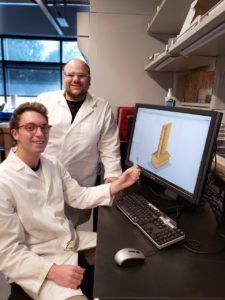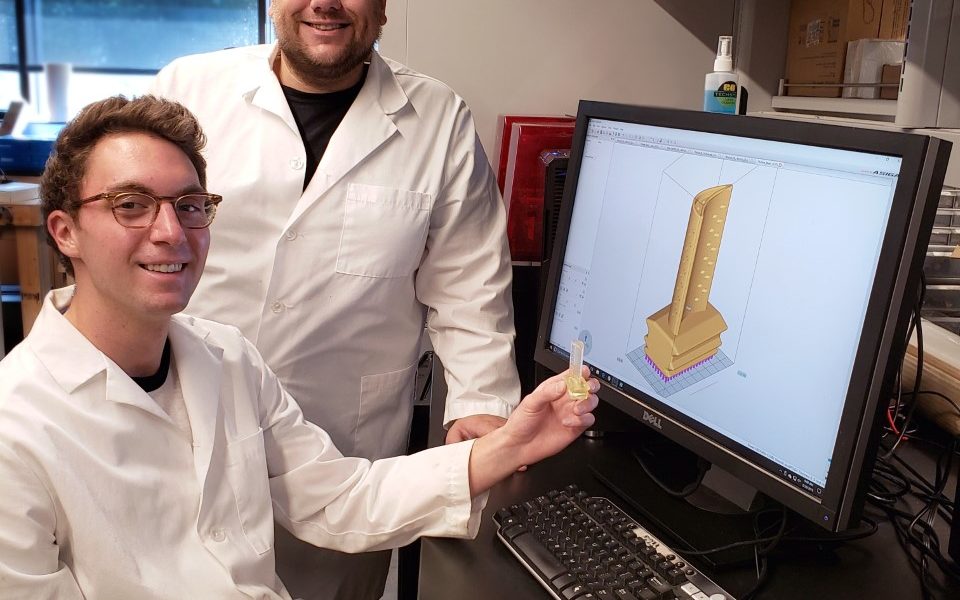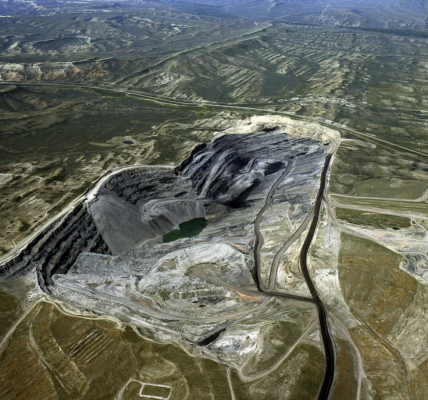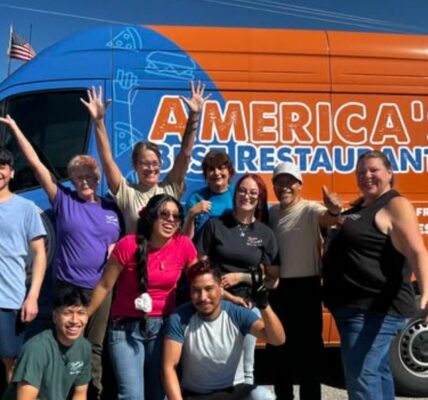By Mark Wilcox
Wyoming Business Report
Via- Wyoming News Exchange

Wyoming isn’t typically known for being on the cutting edge of technology, but when it comes to 3D printing, research about and usage of the slowly maturing technology has already found a home.
For instance, ceramic-printing research at the University of Wyoming could someday allow people to fly farther for cheaper. In Jackson, inexpensive prototyping has helped one company save time and money. And in Sheridan, 3D printers are already churning out complex parts that only 3D printers can handle.
In short, Wyoming companies and researchers are proving use cases for a technology that many see as a novelty, rather than useful on an industrial scale. And according to those already using it, more businesses and industry will soon catch the technology train leading to 3D Printville.
As 3D printers become more ubiquitous, and researchers learn to print a wider range of material, the manufacturing process itself could change in the Cowboy State. But more importantly, the way people think about the design process may evolve.
The move would take industry from a world of subtractive manufacturing – machining blocks of materials to make them a desired form – toward one that factors in additive manufacturing. The latter builds parts layer by layer with a 3D printer from the ground up – no wasted material, no machining necessary.
“It can initially be difficult to understand how to make the most of each type of technology to optimize product development and manufacturing,” said digital fabrication company Formlabs in a blog post. “Both have cases where it makes sense to use one approach over the other. For example, one process can be more useful for a certain production volume, or at a specific stage of product development.”
The following Wyoming researchers and companies are currently sifting the use cases and finding exactly where additive manufacturing makes the most sense. It’s a paradigm shift that industry may need decades to wrap its head around, researchers said.
For Carl Frick and Ray Fertig, the “super eclectic” industry of 3D printing could literally allow jet turbines to take more heat. That’s an improvement which increases efficiency, allowing a plane to fly a route with less fuel weighing it down. Or simply to go farther with the fuel it has.
The UW researchers work together in the school’s Department of Mechanical Engineering and recently secured a $1 million grant from the U.S. Department of Energy to research how to print ceramic gas turbine vanes. Specifically, vanes with built-in cooling channels impossible to create through subtractive manufacturing.
The three-year project stemmed from a foray into looking at new coal-based resins and additives to add value to the state’s flagging coal industry, Fertig said. In the process, they discovered ceramics printing and conceptualized printing ceramic vanes for gas turbine engines.
Heat-resistant ceramics can’t be worked in the same ways as metals, and internal cooling channels can’t be built into metal parts anyway with subtractive manufacturing.
“We build the part from the ground up,” Frick said. “It would be impossible to make it any other way.”
But additive manufacturing for ceramics is in its infancy. It starts with a vat of plastic resins and ends up with silicone-based ceramics. While the concept works, it doesn’t work well enough to guarantee integrity for an engine spinning the part at up to 25,000 rounds per minute while flying passengers seven miles above the ground.
Materials quality and integrity of 3D-printed materials has held the additive manufacturing business back until now, Fertig said.
“It works fine for little Yoda dolls or whatever you want to do, but it’s frequently not what you need for industrial applications,” Fertig said. “How do we make our ceramics as good or better than the traditional process?”
The answer, in part, is to hire on UW mechanical engineering grad student Stephan Brinckmann to the research project.
“My role in this whole thing is coming up with the materials and getting them to 3D print, which is not so trivial,” Brinckmann said.
It starts with a tub full of liquid plastics. The plastics have in them a chemical reactive to ultraviolet light. Using an ultraviolet light emitting diode, or LED, or a laser that’s visible to the naked eye transforms the liquid into a solid.
Using high-precision instruments, they can target exactly what liquid gets exposed to the light, building layer upon layer of solids within the liquids to “burn out the nasty stuff.” The result is a silicone-based ceramic. By comparison, most plastics have a carbon backbone.
According to Brinckmann, the process isn’t unique.
“In my world, it’s run of the mill,” he said.
But the chemical structure of the materials, on the other hand, is unique.
“It’s a huge struggle to get ceramic materials to be 3D printable,” Brinckmann said. But if they can overcome the challenges, the industrial world opens.
“We can circumvent traditional costs of building our own molds,” Brinckmann said. “We can develop a single structure, import it to the software for the printer, and any design you think of we can create physically.”
Each mold that never has to be created can save a manufacturer $12,000 or more. To make the ceramics process more industry friendly, Brinckmann is “playing around” with different reactive chemicals to add into the base resins that will allow for greater strength and integrity in a finished ceramic. Currently, he said, the printed materials have hairline cracks that won’t be able to withstand industrial usage.
Meanwhile, Fertig and Frick are examining other ways to uphold printed ceramics’ integrity.
“Our claim to fame is a paper we wrote a couple years ago on being the first to demonstrate printing of a 3D matrix composite – ceramic filled with fibers, essentially,” Fertig said. The fibers help hold the material together and toughen it. But while it’s now possible to “print what looks like a blade,” the process is years from where it could be used in an actual gas turbine.
Frick said the technology, once perfected, will start in small engines – likely military drones – and gradually scale up into other uses. The energy industry, he said, will lag far behind, despite the potential efficiency improvements that could help save a lot of fuel at scale in power plants and turbines used for generation.
“Energy is big business,” Frick said, “but not particularly innovative.”
But while that industry takes its time to take advantage of the 3D printing industry, others are all in and identifying new uses for the technology all the time.
According to Frick, using additive manufacturing to make things we can already do well and cheaply at scale with subtractive manufacturing makes little sense.
“That’s a mistake,” he said. “Manufacturers need to start with a new problem.”
Therefore, things like the automotive industry are unlikely to adopt 3D printing anytime soon. The entire process of mass production was designed around conventional techniques. It would cost untold fortunes to scrap those processes and build around additive processes. Until a car is fundamentally different enough that it doesn’t work within the constraints of traditional manufacturing, the industry will never make the switch.
But a problem like ceramic blades needing built-in cooling channels makes sense to tackle with additive manufacturing. And other, simpler uses of the technology are already in production in Wyoming.
Fertig called the “newest, latest and greatest” in the state a 3D-printed part made by Ramaco Carbon on behalf of firearms manufacturer Weatherby. The part is a recoil pad that soaks up shock from shooting a gun with a complex internal matrix of latticework.
“They wouldn’t be able to manufacture it otherwise,” Fertig said. “Additive will always be behind the curve if replicating conventional techniques. But now we’re designing in ways we’ve never done before – exploring things we’ve never considered.”
According to Megan Gresham, director of sales at Ramaco Carbon, 3D printing, like what it’s doing for Weatherby, is the only income stream so far for the young company. Originally, the company launched to turn Wyoming coal into consumer products (see the December print issue of Wyoming Business Report). But while it works on that technology, it’s using conventional carbon-based feedstock for its 3D printer farm in Sheridan. The goal is to eventually replace that with materials from the mine Ramaco wants to open in Sheridan.
The company currently runs five 3D printers, and each takes about three hours to create one recoil pad.
“Its lattice shape is unmoldable,” Gresham said. “It’s light and made with a tough plastic rubber.”
The pad affixes to a rifle that weighs less than five pounds overall, making it a great fit for a field rifle. The company currently produces about 300 of the pads per month for Weatherby – a company that resides just down the road.
Currently, Ramaco is geared up for expansion as partners like Weatherby come along through digital networking and other channels.
“It’s definitely an expanding industry as far as plastics go,” Gresham said. She added that the industry has grown 500% since 2014. According to data specialists Wohlers, 3D printers sold about 20,000 units in 2011, compared to about 420,000 units in 2016. And industrial-scale printers are finally finding homes with a “significant” jump in industrial-class polymer printer sales in 2017, the most recent data available.
Furthermore, additive manufacturing from polymer bases like what Ramaco does grew at 29% between 2014 and 2017. The hockey-stick growth is pointing to the sky as the limit.
“There is a lot of room to expand in terms of what’s currently injected molded,” Gresham said. “Everything is going to get bigger, faster, cheaper, and we’re at the forefront of that.”
For Gresham, once a reluctant expatriate of her home state of Wyoming, that means more quality jobs in Wyoming will ramp up.
For other Wyomingites, 3D printing is part of the design process or for learning, rather than for use in end products.
Back at the University of Wyoming, for instance, petroleum engineering undergrad Mike Gardner printed out a model of drill bit common to the energy industry to demonstrate to other students a major component of their future careers.
“This has been a learning process,” he said, indicating he’s used it to learn his 3D modeling program as much as anything. “The first one didn’t come out fully working – I have to go back through the model and recreate new pieces to make it workable. But I’ll be able to print it in one print, and with ball bearings inside the cone.”
While his model is made of plastics, the university does have a metal printer that could potentially create a fully functional version. But Gardner doesn’t see that happening.
“The metal printer is so wrapped up that students don’t have access to it,” he said. “It’s not exactly the safest printer in the world.”
Since the printer uses a laser to combust metal, he said “bad things can happen if you get things wrong.”
Still, the plastic version serves as validation.
“If I wanted to design a specific part, it’s a proof of concept, in my eyes,” he said, holding up his printed bit about the size of his head. “This bit here I can connect onto a pipe – the threads work with piping.”
So he anticipates that the technology will stay more on the conceptualization side for industry versus the realization side, except possibly for extremely specialized parts that would be cost-prohibitive to produce using conventional means on small runs. For example, Gardner said one person in his program is currently printing parts for his car that he can’t buy in the U.S.
Conceptualization is also how Bob Fuziak and his team at Armsreach Industries have used the technology. The Jackson-based company used 3D printing to print out prototypes of its Night Caddy, a bedside tray to hold everything from cellphones to water bottles in places where a bedstand isn’t possible due to space or other constraints.
“My whole everything was based on 3D printing because I’m not in a company with the ability to manufacture or design or prototype anything – it’s my own made-up stuff,” Fuziak said. “The only way to get that out of my head and into my hand cost-effectively was 3D printing.”
Doing so allowed him to get proof of concept for not only this product, but for a stalled former project that attached a pivoting camera to a pair of sunglasses. And for that project, seeing it in real life helped him see where things were too small or thin, where stress tolerance would be an issue, and more.
“Once printed, some prototypes just weren’t worthy,” he said. For him, 3D printing was the bridge between the dreamer architect and the pragmatic builder unafraid to say, “You can’t build that!”
For him, it’s been a game changer that has helped him sell 25,000 Night Caddies since debuting in 2016.
“Before 3D printers, I had electrical tape, duct tape, cardboard, Legos – it was whatever you could do to get something out of your head and into your hand. Now, it’s totally different.”
Taken together, Wyoming businesses are already using 3D printing in both the conceptualization and realization stages of manufacturing. But the evolving field is far from settled, leaving many to question what everything will look like as the industry matures.
“When does additive make sense?” Frick asked. “Right now, it’s hard to understand what’s real and what’s not. We’re about 10 years away from understanding where the technology will lead.”
For Frick, the technology makes most sense for customizable things, rather than mass production. Orthopedic doctors can use the technology to make custom-fit technologies for individual patients, improving healing times or function with permanent medical devices.
He thinks until design principles catch up to the technology, little headway will be made in replacing subtractive manufacturing en masse. And, indeed, it probably shouldn’t.
Fertig, the other UW professor working on the turbine vane project, said additive manufacturing works for specialty parts or short runs of 1,000 pieces or fewer.
For now, though, UW is doing its best to seed the next generation of makers with exposure to the techniques and tools of the additive industry. As more engineers and entrepreneurs understand the ramifications of additive manufacturing, it will become more widespread and effective.
“We’re happy to explore (3D printing) further, and be the conduit to community and students,” Frick said. “It’s very obviously a trend that evolves in the future. It’s about … evolving it into potential products and technology of interest to people in Wyoming.”







